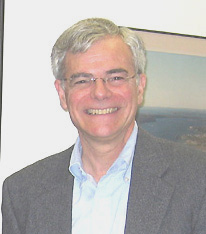
| T H E N I H C A T A L Y S T | M A Y – J U N E 2007 |
|
|
|
| F R O M | T H E | D E P U T Y | D I R E C T O R | F O R | I N T R A M U R A L | R E S E A R C H |
BUDGET BLUES
 |
| Michael Gottesman |
The recent article in Science (316: 968, 2007) focusing on budget difficulties in the intramural program at NICHD underscores what intramural staff have known now for several years: that significant belt-tightening is necessary for intramural NIH to get through this period of flat budgets accompanied by inflation—and the resulting decrease in our buying power.
The intramural budget for 2007 has increased by 4.2 percent since 2004, from $2.66 billion to $2.77 billion, which includes a significant investment in biodefense. But when corrected for the biomedical inflator, this increase actually translates to a 7.5 percent decrease in buying power (the extramural NIH budget has felt the same pinch at a time of increasing grant applications, bringing pay lines for extramural grantees to historic lows).
In general, the budget taps that support NIH infrastructure have not increased at a rate greater than the average increase in the NIH intramural budget over the past three years. In other words, these taps have stayed at about the same percent of the NIH budget as they were three years ago—with three exceptions.
![]() The Clinical Center budget has actually
declined as a percent of the total (this number may somewhat underestimate the
effect on the intramural budget since some of the charges previously incorporated
into the Clinical Center budget, such as laundry and housekeeping services,
are now being paid directly by the Institutes and Centers).
The Clinical Center budget has actually
declined as a percent of the total (this number may somewhat underestimate the
effect on the intramural budget since some of the charges previously incorporated
into the Clinical Center budget, such as laundry and housekeeping services,
are now being paid directly by the Institutes and Centers).
![]() Increases in the budget of the Office of Research
Facilities have been driven primarily by record utility-rate increases and
the overall increase in IRP square footage; examples are the Porter Neuroscience
Research Center, the Clinical Research Center, and the C.W. Bill Young Center
for Biodefense and Emerging Infectious Diseases (Building 33).
Increases in the budget of the Office of Research
Facilities have been driven primarily by record utility-rate increases and
the overall increase in IRP square footage; examples are the Porter Neuroscience
Research Center, the Clinical Research Center, and the C.W. Bill Young Center
for Biodefense and Emerging Infectious Diseases (Building 33).
![]() The budget of the Office of Research
Services also has a slightly higher share related to increased security
costs at NIH in the past three years. Overall, however, the ORS has had to identify
$21 million in cost savings to cover inflationary increases during that time
period. Although most intramural investigators have felt the sting of this budget
pinch, several steps have been taken by the scientific directors (SDs) to soften
the
blow for our most outstanding investigators.
The budget of the Office of Research
Services also has a slightly higher share related to increased security
costs at NIH in the past three years. Overall, however, the ORS has had to identify
$21 million in cost savings to cover inflationary increases during that time
period. Although most intramural investigators have felt the sting of this budget
pinch, several steps have been taken by the scientific directors (SDs) to soften
the
blow for our most outstanding investigators.
A major step has been a reduction in scientific programs with 58 fewer principal investigators (PIs) at NIH than three years ago (a 5 percent decrease). During this period 108 PIs were hired (both tenured and tenure-track), indicating that a total of 166 PIs lost this status during this three-year period, but recruits continued to arrive to bring us to the current figure of 1194 PIs.
One trans-NIH approach to deal with our budget woes is to make the existing dollars go further, our dollar-stretching activities.
Committees dealing with procurement, travel, animal use, personnel, telecommunications, and space have made recommendations on ways to save money that are currently being implemented. More information about these dollar-stretching activities will be forthcoming.
Budget reductions are difficult for existing programs with large fixed personnel costs that have risen as a percentage of lab budgets over the past three years, and many intramural programs have seen significant reductions in their discretionary budgets (those parts of the budget for equipment, supplies and services).
The SDs have tried to avoid across-the-board budget cuts wherever possible, preserving funds for tenure-track investigators, new recruits, and especially exciting new science. This policy becomes more and more difficult to follow, however, as flat budgets and declining purchasing power persist. The result in some cases may be general budget cuts.
Ultimately, additional program cuts will be necessary, and the SDs will depend on the wise advice of our Boards of Scientific Counselors to make the right ones.
Intramural NIH has been through this kind of budget constriction in the past and has remained a vital, creative research facility.
—Michael
Gottesman
Deputy
Director for Intramural Research